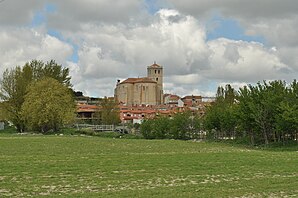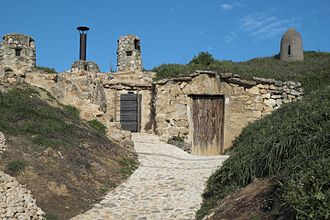Mucientes
| Mucientes municipality | ||
|---|---|---|
 Mucientes - the townscape with Iglesia de San Pedro Apóstol
|
||
| coat of arms | Map of Spain | |
 Help on coat of arms |
|
|
| Basic data | ||
| Autonomous Community : |
|
|
| Province : | Valladolid | |
| Comarca : | Campiña del Pisuerga | |
| Coordinates | 41 ° 45 ′ N , 4 ° 46 ′ W | |
| Height : | 775 msnm | |
| Area : | 63.82 km² | |
| Residents : | 662 (Jan. 1, 2019) | |
| Population density : | 10.37 inhabitants / km² | |
| Postal code : | 47194 | |
| Municipality number ( INE ): | 47098 | |
| administration | ||
| Website : | Mucientes | |
Mucientes is a northern Spanish town and municipality ( municipio ) with 662 inhabitants (as of January 1, 2019) in the province of Valladolid in the autonomous region of Castile-León ; the community belongs to the " Cigales DO " wine-growing region .
location
The place Mucientes is located near the Autovía A-62 at an altitude of approx. 775 m . The distance to the southern provincial capital Valladolid is just under 13 km (driving distance). The climate in winter is harsh, but in summer it is dry and warm; the rather sparse rain (approx. 435 mm / year) falls mainly in the winter half-year.
Population development
| year | 1857 | 1900 | 1950 | 2000 | 2017 |
| Residents | 1,446 | 1,375 | 1,234 | 617 | 681 |
Because of the mechanization of agriculture and the abandonment of small farms, many workers and their families migrated to the larger cities in the second half of the 20th century ( rural exodus ); Due to the relative proximity to the city of Valladolid, the population of the municipality has increased again slightly in recent decades.
economy
The area around Mucientes was and is to a large extent agricultural, with animal husbandry traditionally playing a less important role; the place offered the necessary regional services in the fields of handicraft and trade. In the 19th century, the Canal de Castilla was passed east of the municipality. Mucientes is part of the small wine-growing region " Cigales "; tourism only plays a subordinate role.
history
Around 400 BC The area was inhabited by the Celtic ethnic group of the Vaccaeans . In the 2nd century BC BC the Romans brought large parts of the Iberian Peninsula under their control; they also brought the art of viticulture with them. In the 5th century AD the Vandals came , but they were pushed to North Africa by the Visigoths . In the 8th century, Arab-Moorish armies advanced far to the north, but were unable to conquer the areas north of the Cantabrian Mountains ( Basque Country , Cantabria , Asturias , Galicia ). Already in the 10th and 11th centuries they were forced to the south by Christian armies ( reconquista ) , with the Duero valley, about 25 km south of Mucientes, delimiting the respective spheres of influence for a long time. The place name Muz-nentis is documented for the first time in a document from 1114 . In July 1506, Joan I of Castile and her newly wedded husband Philip of Austria stopped at the castle of Mucientes; he planned to have his wife declared by the assembly of estates ( Cortes ) for insane, but this refused. Two months later he died of a fever in Burgos .
Attractions

- From the medieval castle (castillo) , mentioned here for the first time in 1275 (palacio) , only the foundation walls are preserved. Until the 1930s was still a part of the keep (Torre del homenaje) upright.
- The Iglesia de San Pedro Apóstol , built in the Gothic style from precisely hewn stones in place of a demolished Romanesque church in the 16th century , has only one nave, but has a transept . The bell tower (campanario) erected above the northern arm of the transept belongs to a second construction phase and already shows clear, but unadorned Renaissance forms .
- outside
- The baroque Ermita de Nuestra Señora de la Vega , built in the 17th century, stands about 1 km southeast of the village and has an imposing bell gable (espadaña) .
- On the outskirts there are numerous cellar vaults ( bodegas ) dug into the stone-interspersed soil for storing wine and food. Some can be visited.
literature
- Carlos Duque Herrero: Mucientes. Historia y Arte. Grupo Página, Valladolid 1997, ISBN 978-84-922407-0-8 .
Web links
- Mucientes - Photo + Info (Spanish)
- Mucientes - Photos + Quick Facts (Spanish)
Individual evidence
- ↑ Cifras oficiales de población resultantes de la revisión del Padrón municipal a 1 de enero . Population statistics from the Instituto Nacional de Estadística (population update).
- ↑ Mucientes - climate tables
- ↑ Mucientes - Population Development
- ↑ Mucientes - Church ( Memento of the original from October 12, 2018 in the Internet Archive ) Info: The archive link was automatically inserted and not yet checked. Please check the original and archive link according to the instructions and then remove this notice.
- ↑ Mucientes - Ermita
